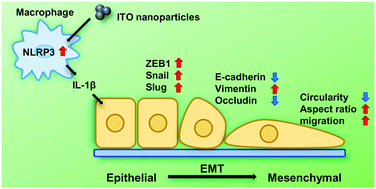Interleukin-1β released from macrophages stimulated with indium tin oxide nanoparticles induces epithelial-mesenchymal transition in A549 cells†
Abstract
Epithelial–mesenchymal transition (EMT) is a crucial process by which epithelial cells lose polarity and acquire migratory mesenchymal properties, eventually leading to tissue fibrosis and cancer. Indium tin oxide (ITO) is one of the most widely manufactured materials with broad applications, such as flat panel displays, touch panels, and solar panels. Whereas cases of indium-related lung disease have been reported worldwide, the effects of ITO on the progression of EMT are completely unknown. In the current study, we explored whether ITO nanoparticles (NPs) induce EMT in human alveolar epithelial cells (A549 cells). We found that although ITO NPs did not directly induce EMT in A549 cells, a conditioned medium (CM) obtained from THP-1-derived macrophages (dTHP-1 cells) stimulated with ITO NPs induced morphological changes, high motility, and EMT progression in A549 cells. After co-culture with ITO NP-treated dTHP-1 cells, A549 cells exhibited morphological and molecular signatures of EMT. Furthermore, we identified that interleukin-1β (IL-1β) produced via the activation of nod-like receptor protein 3 (NLRP3) inflammasome is an ITO NP-mediated EMT inducer based on the results of cytokine array as well as cellular physiological and biochemical analysis. Our results also indicated that the IL-1β-mediated EMT occurs not only in A549 cells, but also in bronchial epithelial cells (BEAS-2B cells) and primary human alveolar epithelial cells (hAEC). In addition, a neutralizing antibody against IL-1 receptor can effectively inhibit the induction of EMT caused by CM from ITO NP-treated dTHP-1 cells. Taken together, these findings suggest that IL-1β is released from macrophages stimulated with ITO NPs and is able to induce EMT progression in A549 cells, thereby potentially triggering the genesis and development of pulmonary fibrosis.



 Please wait while we load your content...
Please wait while we load your content...